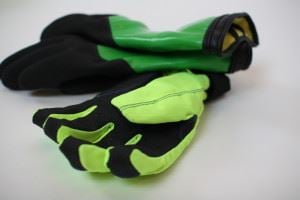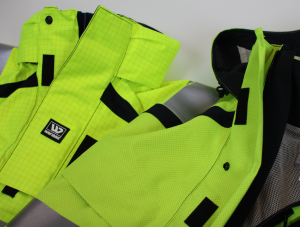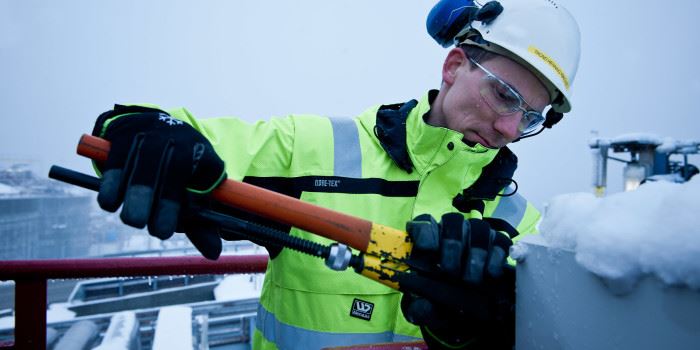WORK CLOTHING: Work clothing specifically tailored to Arctic conditions is hard to find. But industrial designers have now joined forces with researchers to create the perfect clothing concept. And they’re both consulting with the men and women who have to work in gale force winds in the Barents Sea at temperatures as low as 20 degrees below freezing.
“Today, deck operators on oil rigs working in the Barents Sea are still wearing traditional cotton coveralls because work clothing tailored to Arctic weather conditions and associated risk factors simply doesn’t exist”, says industrial designer and SINTEF researcher Ole Petter Næsgaard.
The need for a new generation of work clothing has inspired textile manufacturers Wenaas to invest in research work. Wenaas is a leading supplier of work clothing to the oil and gas industry and aims to develop a clothing concept tailored both to the harsh Arctic weather conditions and the tasks that workers have to carry out.
Such clothes must not only provide effective protection against the wind and weather, but must also be durable, fire-proof, anti-static and designed to accommodate the use of hearing protection and communications equipment. This places great demands on both textiles and design.
“Wenaas is lending us its expertise and high-quality products so that we can work closely together on this project and learn from each others’ experience”, says Næsgaard.

Several different types of gloves have been developed as part of this project. These have been specially designed to conform to the natural curvature of the fingers and are fitted with an inner woollen lining to keep the hands warm. The gloves in the background are specially developed for work in wet and cold conditions. Photo: SINTEF
Click to open
Workers set the standard
Wenaas selected SINTEF for this project because of the researchers’ previous experience in the development of customised clothing for fishermen and fish farm workers, as well as survival suits worn by offshore workers during helicopter transit to and from platforms on the Norwegian shelf.
The researchers have chosen to approach this project by letting the workers themselves set the standards. After in-depth interviews with more than 20 technical professionals with experience from operations in the Barents Sea, and observing deck operators at work on a rig over several days, the researchers sat down at their drawing boards with notebooks stuffed with excellent ideas and suggestions.
“A major issue that emerged was that an ideal clothing concept would have to meet a set of contradictory requirements”, says Næsgaard. “There is a clear need for protection against wind and moisture. The clothing must not only provide protection against a long series of risk factors, but must also be able to withstand rough handling”, he says. “Moreover, workers move between tasks of vastly varying levels of intensity. Insulated thermal suits make the wearers sweat too easily when they’re very active. Those who have worked under these demanding weather conditions commonly find it difficult to regulate their temperature according to their needs”, explains Næsgaard, who is heading SINTEF’s contribution to the project.
So the task facing the researchers is to develop clothing that not only provides protection against harsh weather conditions, but is also breathable and practical. And, not least, to link clothing development to physiological data accumulated by SINTEF during years of research in its occupational physiology laboratory into how the body responds to the stresses imposed on it under extreme conditions.
After eighteen months of development in close collaboration with Wenaas, the result is a clothing concept that not only protects, but also offers a series of practical and technical subtleties. So what do we call it? “Arctic Protection” – naturally.
“The tasks that this group of workers carry out are so varied that it is essential they are given a lot of freedom of movement”, says Næsgaard. “They spend some of their time suspended from climbing harnesses, and this inspired us to study the clothing worn by today’s climbers” he says. But the fabrics must be resistant to more than just the moisture from rain and snow. High-pressure hosing of equipment is a good example of a regular job on deck.
Layer by layer
The clothing concept is divided into several layers with the aim of making it easier to regulate insulation properties according to different weather conditions and work tasks. Priority is also given to practical functions, making it easy to use communications equipment and hearing protection devices.
“A common problem today is that face masks and balaclavas are difficult to combine with hearing protection devices without the latter slipping and compromising noise protection”, explains Næsgaard. “Our solution is a specially-adapted balaclava made up of “zones” of fabrics of different thicknesses, each with its own function. This means that it works well both beneath a helmet and when wearing ear defenders”, he says.
As a base layer, researchers have selected something as unconventional as woollen underwear.
“There is no fabric that can out-perform wool when it comes to providing thermal protection in wet conditions”, says Næsgaard. “Standard woollen underwear is worn by many rig workers today, and they’re very happy with its performance. Wool also meets the fireproofing standards required of all layers in contact with the skin”, he says.
However, when it comes to the intermediate layer, a lot of work has gone into developing a novel and more technical fabric. This is reminiscent of a medium-thick fleece, with a highly three-dimensional and airy structure enabling it to provide adequate ventilation when the wearer is active, and insulation when he or she is at rest. But even here, 50 per cent of the fabric is wool.
FACTS
Name of project: Arctic Protection
Funding: the Research Council of Norway's Petromax II programme.
Statoil and Eni Norge are participating as user representatives and co-funders.
The work clothing manufacturer Wenaas is acting as Project Manager, while SINTEF is heading the R&D project.
Major heat loss around the legs
The outer layer, or shell, has a waterproof and breathable membrane. A work clothing version of Gore-Tex is one of the textiles currently being tested. Major focus has been directed on the design to ensure that communications equipment is both easily accessible and at the same time not obstructive when the wearer is actively working.
The researchers have also spent a lot of time and energy looking into leg coverings.

Researchers are currently testing two different types of fabrics for possible use in the shell layer. Both are coated with a membrane that provides effective protection against wind and moisture. However, they have different moisture-wicking properties. The lining fabric has been chosen to reduce moisture accumulating on the inside of the garments when the wearer is very active. Photo: SINTEF
Click to open
“We’ve noted that keeping the leg area around and below the thighs warm is critical to a wearer’s sense of feeling warm enough”, says Øystein Wiggen, who is the physiologist responsible for testing the clothing concept. “At the same time it’s easy to lose a lot of heat from the legs because they’re less sensitive to cold”, he says.
The clothing concept also includes a new winter glove designed to conform to the natural curvature of the human hand. This enhances mobility and the wearer’s ability to grip objects in cold conditions. And in response to requests from workers, the glove has a woollen inner lining and built-in shock absorbance in the sections protecting the knuckles.
Every modification tested
Throughout its development, the clothing concept has been tested at SINTEF’s occupational physiology laboratory.
“It’s very important to us to be able to document the reasons behind the decisions we’ve made”, explains Wiggen. “Last winter the concept underwent field tests”, he says. “We’ve now carried out some improvements and Wenaas has manufactured a large number of prototype garments ready for a new set of tests at three locations operated by Statoil and Eni Norge. This may well mean that we’ll have to make even more adjustments. User involvement is the key to our success with this project”, says Wiggen.
The research team is hoping that the new clothing concept will seen as relevant to other groups of workers that sometimes have to work under extreme conditions, such as in the construction and mining (especially quarrying) industries, as well as electricians carrying out inspections and repairs in connection with high-voltage power lines.

